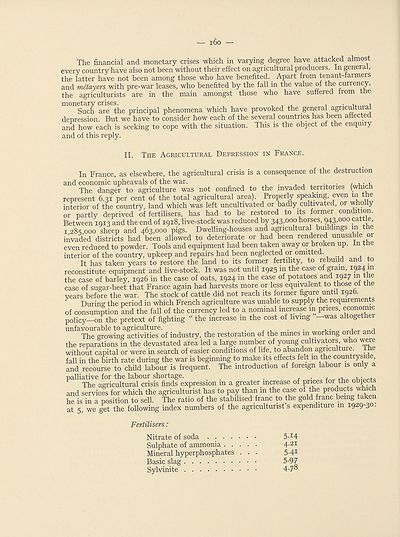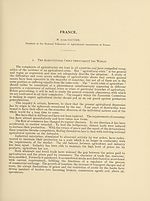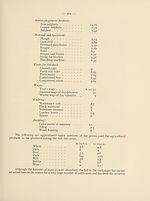Download files
Complete book:
Individual page:
Thumbnail gallery: Grid view | List view

— i6o
The financial and monetary crises which in varying degree have attacked almost
every country have also not been without their effect on agricultural producers. In genera ,
the latter have not been among those who have benefited. Apart from tenant-farmers
and metayers with pre-war leases, who benefited by the fall in the value of the currency,
the agriculturists are in the main amongst those who have suffered from tne
monetary crises. , n .
Such are the principal phenomena which have provoked the general agricultura^
depression. But we have to consider how each of the several countries has been affected
and how each is seeking to cope with the situation. Ihis is the object of the enquiry
and of this reply.
II. The Agricultural Depression in France.
In France, as elsewhere, the agricultural crisis is a consequence of the destruction
and economic upheavals of the war. . . x .. . , , • ,
The danger to agriculture was not confined to the invaded territories (which
represent 6.31 per cent of the total agricultural area). Properly speaking even m the
interior of the country, land which was left uncultivated or badly cultivated, or wholly
or partly deprived of fertilisers, has had to be restored to its former condition.
Between 1913 and the end of 1918, live-stock was reduced by 343,000 horses, 943,000 cattle,
1 285,000 sheep and 463,000 pigs. Dwelling-houses and agricultural buildings m the
invaded districts had been allowed to deteriorate or had been rendered unusable or
even reduced to powder. Tools and equipment had been taken away or broken up. In the
interior of the country, upkeep and repairs had been neglected or omitted.
It has taken years to restore the land to its former fertility, to rebuild and to
reconstitute equipment and live-stock. It was not until 1925 m the case of gram, 1924 m
the case of barley, 1926 in the case of oats, 1924 in the case of potatoes and 1927 m the
case of sugar-beet that France again had harvests more or less equivalent to those of the
vears before the war. The stock of cattle did not reach its former figure until 1926.
During the period in which French agriculture was unable to supply the requirements
of consumption and the fall of the currency led to a nominal increase in prices, economic
policy—on the pretext of fighting “ the increase m the cost of living —was altogether
unfavourable to agriculture. , . . ... , •,
The growing activities of industry, the restoration of the mines m working order and
the reparations in the devastated area led a large number of young cultivators who were
without capital or were in search of easier conditions of life, to abandon agriculture. I he
fall in the birth rate during the war is beginning to make its effects felt m the countryside,
and recourse to child labour is frequent. The introduction of foreign labour is only a
palliative for the labour shortage. . * • o w nhWts
The agricultural crisis finds expression in a greater increase of prices for the objects
and services for which the agriculturist has to pay than m the case of the products which
he is in a position to sell. The ratio of the stabilised franc to the gold franc being taken
at 5 we get the following index numbers of the agriculturist s expenditure m 1929-30.
Fertilisers:
Nitrate of soda 5-I4
Sulphate of ammonia 4-21
Mineral hyperphosphates ... 5-41
Basic slag 5-97
Sylvinite 4-7°
The financial and monetary crises which in varying degree have attacked almost
every country have also not been without their effect on agricultural producers. In genera ,
the latter have not been among those who have benefited. Apart from tenant-farmers
and metayers with pre-war leases, who benefited by the fall in the value of the currency,
the agriculturists are in the main amongst those who have suffered from tne
monetary crises. , n .
Such are the principal phenomena which have provoked the general agricultura^
depression. But we have to consider how each of the several countries has been affected
and how each is seeking to cope with the situation. Ihis is the object of the enquiry
and of this reply.
II. The Agricultural Depression in France.
In France, as elsewhere, the agricultural crisis is a consequence of the destruction
and economic upheavals of the war. . . x .. . , , • ,
The danger to agriculture was not confined to the invaded territories (which
represent 6.31 per cent of the total agricultural area). Properly speaking even m the
interior of the country, land which was left uncultivated or badly cultivated, or wholly
or partly deprived of fertilisers, has had to be restored to its former condition.
Between 1913 and the end of 1918, live-stock was reduced by 343,000 horses, 943,000 cattle,
1 285,000 sheep and 463,000 pigs. Dwelling-houses and agricultural buildings m the
invaded districts had been allowed to deteriorate or had been rendered unusable or
even reduced to powder. Tools and equipment had been taken away or broken up. In the
interior of the country, upkeep and repairs had been neglected or omitted.
It has taken years to restore the land to its former fertility, to rebuild and to
reconstitute equipment and live-stock. It was not until 1925 m the case of gram, 1924 m
the case of barley, 1926 in the case of oats, 1924 in the case of potatoes and 1927 m the
case of sugar-beet that France again had harvests more or less equivalent to those of the
vears before the war. The stock of cattle did not reach its former figure until 1926.
During the period in which French agriculture was unable to supply the requirements
of consumption and the fall of the currency led to a nominal increase in prices, economic
policy—on the pretext of fighting “ the increase m the cost of living —was altogether
unfavourable to agriculture. , . . ... , •,
The growing activities of industry, the restoration of the mines m working order and
the reparations in the devastated area led a large number of young cultivators who were
without capital or were in search of easier conditions of life, to abandon agriculture. I he
fall in the birth rate during the war is beginning to make its effects felt m the countryside,
and recourse to child labour is frequent. The introduction of foreign labour is only a
palliative for the labour shortage. . * • o w nhWts
The agricultural crisis finds expression in a greater increase of prices for the objects
and services for which the agriculturist has to pay than m the case of the products which
he is in a position to sell. The ratio of the stabilised franc to the gold franc being taken
at 5 we get the following index numbers of the agriculturist s expenditure m 1929-30.
Fertilisers:
Nitrate of soda 5-I4
Sulphate of ammonia 4-21
Mineral hyperphosphates ... 5-41
Basic slag 5-97
Sylvinite 4-7°
Set display mode to:
![]() Universal Viewer |
Universal Viewer | ![]() Mirador |
Large image | Transcription
Mirador |
Large image | Transcription
Images and transcriptions on this page, including medium image downloads, may be used under the Creative Commons Attribution 4.0 International Licence unless otherwise stated. ![]()
| League of Nations > Economic and financial section > Agricultural crisis > Volume 1 > (162) |
|---|
| Permanent URL | https://digital.nls.uk/190904756 |
|---|
| Shelfmark | LN.II.2/2.(35) |
|---|---|
| Attribution and copyright: |
|
| Shelfmark | LN.II.2/2.(35-35) |
|---|---|
| Shelfmark | LN.II |
|---|
| Description | Over 1,200 documents from the non-political organs of the League of Nations that dealt with health, disarmament, economic and financial matters for the duration of the League (1919-1945). Also online are statistical bulletins, essential facts, and an overview of the League by the first Secretary General, Sir Eric Drummond. These items are part of the Official Publications collection at the National Library of Scotland. |
|---|---|
| Additional NLS resources: |
|

